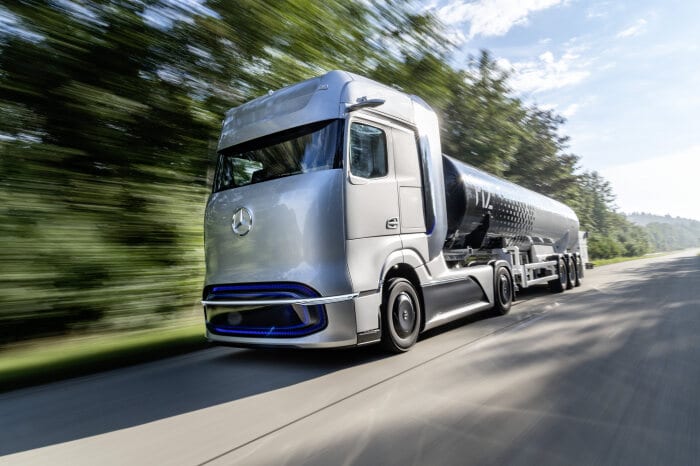
Hydrogen-powered trucks are prominently represented in the National Hydrogen Strategy and represent an opportunity to decarbonise freight transport on the road.
The petrol station infrastructure is a decisive factor for this technology to catch on. The Fraunhofer ISI has calculated that in 2050 a network of 140 filling stations will be enough for fuel cell trucks to cover their entire hydrogen requirements. The costs for this amount to around nine billion euros per year.
Road freight traffic in Germany emits around 50 megatons of CO 2 per year, half of which are accounted for by around 250,000 heavy trucks weighing over 26 tons. In order to achieve the goals of the Paris Climate Agreement, transport must be virtually emission-free by 2050. One possibility for decarbonisation is to completely replace conventionally powered trucks with fuel cell trucks that run on hydrogen.
Sufficient filling stations are necessary to meet the annual demand of around 1.3 million tons of hydrogen and to ensure reliable truck traffic. Although there are already more than 80 filling stations for fuel cell cars across Germany, most of them are not, or only partially, suitable for trucks, as they can neither ensure the required quantities nor rapid refueling.
The Fraunhofer Institute for Systems and Innovation Research ISI has examined what a filling station network for fuel cell trucks should look like by 2050 on the basis of a scientific simulation model.
A fully expanded truck filling station network in Germany in 2050 will have around 140 stations to cover all of the German heavy truck traffic at a total cost of around nine billion euros per year (2050). The stations are distributed relatively evenly over the motorway network; a concentration along the transit routes and in industrial regions can still be seen.
70 filling stations will be needed by 2030
Prof. Dr. Martin Wietschel, who heads the Competence Center Energy Technologies and Energy Systems at Fraunhofer ISI, emphasizes: “By 2030, according to EU guidelines, truck emissions should be 30 percent lower than in 2019. In order to enable the helpful use of fuel cell trucks, many filling stations have to be set up at an early stage: For almost 50,000 vehicles in 2030, 70 hydrogen filling stations, some of which are smaller, are needed to provide spatial coverage. This comparatively high number of filling stations compared to hydrogen sales shows that there is a great need for suitable business models. The question of government funding for truck hydrogen filling stations must also be resolved quickly. ”
Hydrogen production (electrolysis) is also decisive for the success of the infrastructure. In addition to the central generation of hydrogen and its transport to the filling stations, there is the option of building electrolysers at filling stations and generating the hydrogen directly on site. For the second option, the authors of the study recommend oversizing the electrolysers and large hydrogen storage facilities at the filling stations: this makes hydrogen production cheaper, and the truck filling stations, due to their size and high electricity consumption of around 65 terawatt hours per year, can use the highly fluctuating renewable energies integrate well into the energy system and thus relieve it. This flexibility saves around a billion euros per year. In order to achieve the climate goals, it is also important
Source: The Fraunhofer Institute for Systems and Innovation Research ISI analyzes the development and effects of innovations. We research the short- and long-term developments of innovation processes and the social effects of new technologies and services. On this basis, we provide our clients from business, politics and science with recommendations for action and perspectives for important decisions. Our expertise lies in sound scientific competence and an interdisciplinary and systemic research approach.
Read the most up to date Fuel Cell and Hydrogen Industry news at FuelCellsWorks




